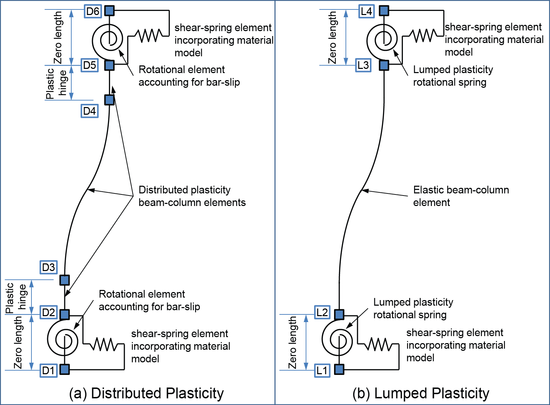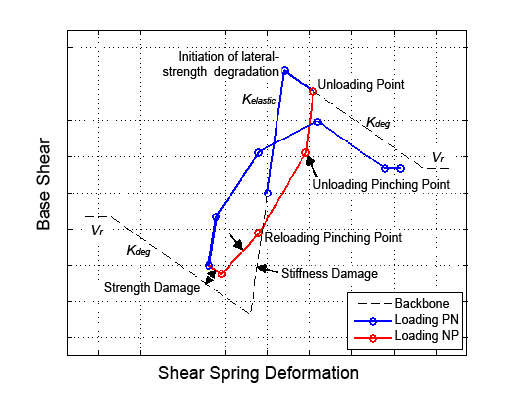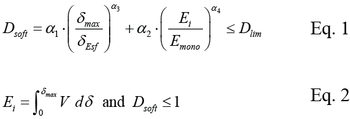Pinching Limit State Material
- Command_Manual
- Tcl Commands
- Modeling_Commands
- model
- uniaxialMaterial
- ndMaterial
- frictionModel
- section
- geometricTransf
- element
- node
- sp commands
- mp commands
- timeSeries
- pattern
- mass
- block commands
- region
- rayleigh
- Analysis Commands
- Output Commands
- Misc Commands
- DataBase Commands
This command is used to construct a uniaxial material that simulates a pinched load-deformation response and exhibits degradation under cyclic loading. This material works with the RotationShearCurve limit surface that can monitor a key deformation and/or a key force in an associated frame element and trigger a degrading behavior in this material when a limiting value of the deformation and/or force are reached. The material can be used in two modes: 1) direct input mode, where pinching and damage parameters are directly input; and 2) calibrated mode for shear-critical concrete columns, where only key column properties are input for model to fully define pinching and damage parameters.
MODE 1: Direct Input
| uniaxialMaterial PinchingLimitStateMaterial $matTag $nodeT $nodeB $driftAxis $Kelas $crvTyp $crvTag
$YpinchUPN $YpinchRPN $XpinchRPN $YpinchUNP $YpinchRNP $XpinchRNP $dmgStrsLimE $dmgDispMax $dmgE1 $dmgE2 $dmgE3 $dmgE4 $dmgELim $dmgR1 $dmgR2 $dmgR3 $dmgR4 $dmgRLim $dmgRCyc $dmgS1 $dmgS2 $dmgS3 $dmgS4 $dmgSLim $dmgSCyc |
| $matTag | unique material object integer tag |
| $nodeT | integer node tag to define the first node at the extreme end of the associated flexural frame member (L3 or D5 in Figure) |
| $nodeB | integer node tag to define the last node at the extreme end of the associated flexural frame member (L2 or D2 in Figure) |
| $driftAxis | integer to indicate the drift axis in which lateral-strength degradation will occur. This axis should be orthogonal to the axis of measured rotation (see $rotAxis in Rotation Shear Curve definition) |
| driftAxis = 1 – Drift along the x-axis
driftAxis = 2 – Drift along the y-axis driftAxis = 3 – Drift along the z-axis | |
| $Kelas | floating point value to define the initial material elastic stiffness (Kelastic); Kelas > 0 |
| $crvTyp | integer flag to indicate the type of limit curve associated with this material. |
| crvTyp = 0 – No limit curve
crvTyp = 1 – axial limit curve crvTyp = 2 – RotationShearCurve | |
| $crvTag | integer tag for the unique limit curve object associated with this material |
| $YpinchUPN | floating point unloading force pinching factor for loading in the negative direction |
| Note: This value must be between zero and unity | |
| $YpinchRPN | floating point reloading force pinching factor for loading in the negative direction |
| Note: This value must be between negative one and unity | |
| $XpinchRPN | floating point reloading displacement pinching factor for loading in the negative direction |
| Note: This value must be between negative one and unity | |
| $YpinchUNP | floating point unloading force pinching factor for loading in the positive direction |
| Note: This value must be between zero and unity | |
| $YpinchRNP | floating point reloading force pinching factor for loading in the positive direction |
| Note: This value must be between negative one and unity | |
| $XpinchRNP | floating point reloading displacement pinching factor for loading in the positive direction |
| Note: This value must be between negative one and unity | |
| $dmgStrsLimE | floating point force limit for elastic stiffness damage (typically defined as the lowest of shear strength or shear at flexrual yielding). |
| This value is used to compute the maximum deformation at flexural yield (δmax Eq. 1) and using the initial elastic stiffness (Kelastic) the monotonic energy (Emono Eq. 1) to yield. Input 1 if this type of damage is not required and set $dmgE1, $dmgE2, $dmgE3, $dmgE4, and $dmgELim to zero | |
| $dmgDispMax | floating point for ultimate drift at failure (δmax Eq. 1) and is used for strength and stiffness damage. |
| This value is used to compute the monotonic energy at axial failure (Emono Eq. 2) by computing the area under the backbone in the positive loading direction up to δmax. Input 1 if this type of damage is not required and set $dmgR1, $dmgR2, $dmgR3, $dmgR4, and $dmgRLim to zero for reloading stiffness damage. Similarly set $dmgS1, $dmgS2, $dmgS3, $dmgS4, and $dmgSLim to zero if reloading strength damage is not required | |
| $dmgE1 $dmgE2 $dmgE3 $dmgE4 | floating point elastic stiffness damage factors α1,α2,α3,α4 shown in Eq. 1 |
| $dmgELim | floating point elastic stiffness damage limit Dlim shown in Eq. 1; Note: This value must be between zero and unity |
| $dmgR1 $dmgR2 $dmgR3 $dmgR4 | floating point reloading stiffness damage factors α1,α2,α3,α4 shown in Eq. 1 |
| $dmgRLim | floating point reloading stiffness damage limit Dlim shown in Eq. 1; Note: This value must be between zero and unity |
| $dmgRCyc | floating point cyclic reloading stiffness damage index; Note: This value must be between zero and unity |
| $dmgS1 $dmgS2 $dmgS3 $dmgS4 | floating point backbone strength damage factors α1,α2,α3,α4 shown in Eq. 1 |
| $dmgSLim | floating point backbone strength damage limit Dlim shown in Eq. 1; Note: This value must be between zero and unity |
| $dmgSCyc | floating point cyclic backbone strength damage index; Note: This value must be between zero and unity |
MODE 2: Calibrated Model for Shear-Critical Concrete Columns
| uniaxialMaterial PinchingLimitStateMaterial $matTag $nodeT $nodeB $driftAxis $Kelas $crvTyp $crvTag $eleTag $b $d $h $a $st $As $Acc $ld $db $rhot $f'c $fy $fyt |
| $matTag | unique material object integer tag |
| $nodeT | integer node tag to define the first node at the extreme end of the associated flexural frame member (L3 or D5 in Figure) |
| $nodeB | integer node tag to define the last node at the extreme end of the associated flexural frame member (L2 or D2 in Figure) |
| $driftAxis | integer to indicate the drift axis in which lateral-strength degradation will occur. This axis should be orthogonal to the axis of measured rotation (see $rotAxis in Rotation Shear Curve definition) |
| driftAxis = 1 – Drift along the x-axis
driftAxis = 2 – Drift along the y-axis driftAxis = 3 – Drift along the z-axis | |
| $Kelas | floating point value to define the shear stiffness (Kelastic) of the shear spring prior to shear failure |
|
Kelas = -4 – Shear stiffness calculated assuming double curvature and shear springs at both column element ends Kelas = -3 – Shear stiffness calculated assuming double curvature and a shear spring at one column element end Kelas = -2 – Shear stiffness calculated assuming single curvature and shear springs at both column element ends Kelas = -1 – Shear stiffness calculated assuming single curvature and a shear spring at one column element end Kelas > 0 – Shear stiffness is the input value Note: integer inputs allow the model to know whether column height equals the shear span (cantelever) or twice the shear span (double curvature). For columns in frames, input the value for the case that best approximates column end conditions or manually input shear stiffness (typically double curvature better estimates framed column behavior) | |
| $crvTag | integer tag for the unique limit curve object associated with this material |
| $eleTag | integer element tag to define the associated beam-column element used to extract axial load |
| $b | floating point column width (inches) |
| $d | floating point column depth (inches) |
| $h | floating point column height (inches) |
| $a | floating point shear span length (inches) |
| $st | floating point transverse reinforcement spacing (inches) along column height |
| $As | floating point total area (inches squared) of longitudinal steel bars in section |
| $Acc | floating point gross confined concrete area (inches squared) bounded by the transverse reinforcement in column section |
| $ld | floating point development length (inches) of longitudinal bars using ACI 318-11 Eq. 12-1 and Eq. 12-2 |
| $db | floating point diameter (inches) of longitudinal bars in column section |
| $rhot | floating point transverse reinforcement ratio (Ast/st.db) |
| $f'c | floating point concrete compressive strength (ksi) |
| $fy | floating point longitudinal steel yield strength (ksi) |
| $fyt | floating point transverse steel yield strength (ksi) |
DESCRIPTION:
The material model coupled with the RotationShearCurve limit surface: 1) has the ability to continually monitor forces and deformations in the flexural elements for conditions that trigger lateral-strength degradation, 2) has a built-in function that compensates for flexural deformation offsets that arise from the degrading behavior of the material in shear springs, and 3) is able to trigger lateral-strength degradation through either a limiting lateral force or element deformations (whichever is reached first). The material introduces several functionalities that give users a high degree of control over the triggering of strength degradation and the ensuing cyclic degrading behavior. Damage algorithms are implemented to control the degrading behavior through elastic stiffness, reloading stiffness, and backbone strength degradation (Fig. 2). The rate of damage accumulation can be controlled by energy-, displacement-, and cycle-based damage computation algorithms.
During the degrading behavior, the model automatically adjusts reloading stiffness to achieve a symmetric global-element lateral load-vs lateral displacement behavior. The model does so by automatically adjusting the reloading stiffness and backbone curve of the material model to compensate for dissymmetry introduced by the unloading of the flexural elements in series with shear springs governed by the model.
DAMAGE:
Damage accumulations effects based on numbers of cycles can be introduced to reloading stiffness and backbone strength through the simple parameters $dmgRCyc and $dmgSCyc with values ranging from 0 to 1.
Elastic stiffness, reloading stiffness, and strength can be adjusted using the following energy and displacement damage model (from Mitra and Lowes (2007)):
EXAMPLE:
PinchingLimitStateMaterial Example
REFERENCES:
1. LeBorgne M. R., 2012, "Modeling the Post Shear Failure Behavior of Reinforced Concrete Columns." Austin, Texas: University of Texas at Austin, PhD, 301.
2. LeBorgne, M.R., Ghannoum, W.M., 2014, "Analytical Element for Simulating Lateral-Strength Degradation in Reinforced Concrete Columns and Other Frame Members," Journal of Structural Engineering, V. 140, No. 7, pp. 04014038 1-12.
3. LeBorgne, M.R., Ghannoum, W.M., 2014, "Calibrated Analytical Element for Lateral-Strength Degradation of Reinforced Concrete Columns," Engineering Structures, V. 81, pp. 35-48.
3. Ghannoum W. M., Moehle J. P., 2012, "Rotation-Based Shear Failure Model for Lightly Confined Reinforced Concrete Columns," Journal of Structural Engineering, V. 138, No. 10, 1267-78.
4. Mitra Nilanjan, Lowes Laura N., 2007, "Evaluation, Calibration, and Verification of a Reinforced Concrete Beam--Column Joint Model," Journal of Structural Engineering, V. 133, No. 1, 105-20.
Code Developed by: Matthew Leborgne and Wassim M. Ghannoum, University of Texas at Austin


